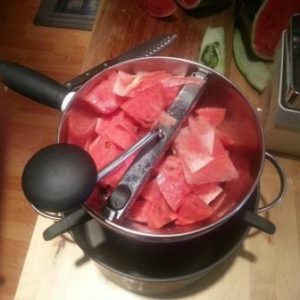This summer at The Micro Farm Project, I planted several types of melons in the garden, each with a deliciously elegant name: Charentais, Crimson Sweet, and Tuscany. But the very best harvest came from a watermelon vine that came up unexpectedly, right in the middle of the lawn. We are calling it “Melonus Unknownus.” I can only guess that the seeds were in my compost pile, the contents of which were spread on the lawn and gardens in the spring. The resulting melons were crisp and sweet, and enormous! Though their origins are a mystery, I have saved the seeds, hoping that they will grow true next year.
At the end of the season, we were meloned-out. I could not bring myself to throw the last melons to the chickens, so I had to come up with another plan quickly. It is my general habit to make jams, pickles and relishes out of excess produce, but never before with melons. Perusing the web for recipes, I found several yummy-looking pickle and relish recipes for the rinds, but not anything that looked promising for making jam out of the gorgeous flesh.
One particular watermelon jam recipe that I found had been posted and re-posted all over the web, but it called for heating the jam, which changes the color of the melon. The recipe looked tasty, but did not add any special ingredients to add depth to the flavor. In order to preserve the lovely pink color, I decided to come up with my own cold-process recipe, and I added a few ingredients to enhance the watermelon flavor.
Ingredients
- 1 medium-sized watermelon
- 2 medium limes or lemons
- 2 -3 cups of pure cane sugar
- 1 tsp kosher or pickling salt
- 1 tsp almond extract (optional)
- 1/2 tsp vanilla extract
- 1 package of instant pectin
- 1 tsp Pickle Crisp food-grade calcium chloride (optional)
Instructions
- Rem
 ove the rind and cut the watermelon into 1-inch cubes.
ove the rind and cut the watermelon into 1-inch cubes. - Slice the limes into 1/2 inch pieces (optional: microwave the limes for 15 seconds each to release the juice)
- Run the watermelon and limes through a food mill or sieve to remove seeds and rinds, and to release the juices. OR remove the watermelon seeds and press the fruit through the holes of a strainer into a bowl to collect the juice. Squeeze the limes to release the juice into the bowl. You do not need to strain out pulp that makes with through the sieve; leave it in the juice to add texture to your jam.
- Pour 8 cups of the juice into a large bowl. Add sugar, to taste (you may need more or less, depending on the sweetness of your watermelon.) Add all of the other ingredients, excluding the pectin, and stir until the sugar is completely dissolved. Calcium chloride is added to preserve the flavor and color of the juice, but it is completely optional.
- Stir in instant pectin, according the the directions on the package. In my case, I used Ball instant pectin, which required me to use nearly the entire jar of pectin, adding it slowly, stirring constantly to prevent clumping. I stirred for three minutes to help activate the pectin.
- Pour the jam into clean canning jars. Leave the jars on the kitchen counter for 24-28 hours, undisturbed, to allow the pectin to set up.
- Store the jars in the fridge for up to two months, or in the freezer for up to one year.
- Serve on toast or scones. Warm slightly and pour over vanilla ice cream. Use as a cake filling, or mix with vanilla icing to make watermelon-flavored frosting. Use as a glaze for poultry, fish or port. Warm slightly and whisk with apple cider vinegar to make a tangy dressing. Warm slightly and mix with vodka for a watermelon martini, or with soda water for a refreshing watermelon shrub.


